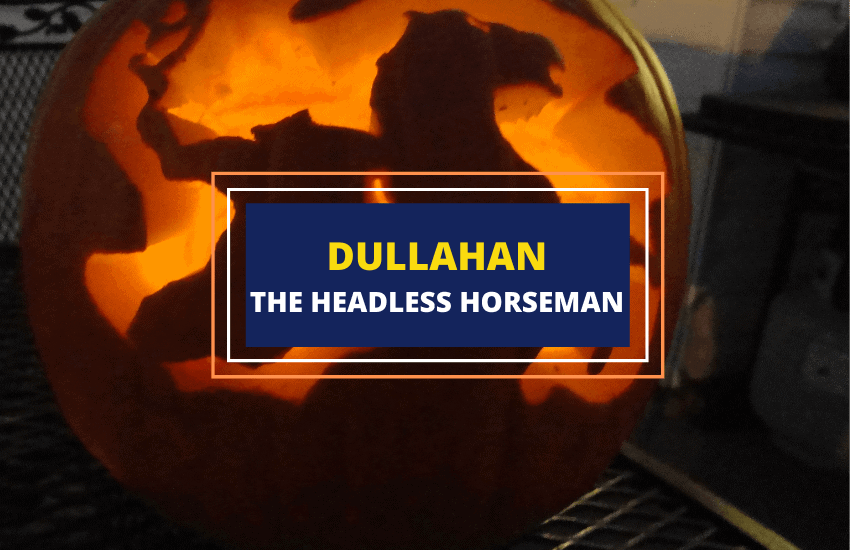
Table of Contents
Most people have heard of the headless horseman – his story is immortalized in multiple novels and other works of art. But few realize that the myth is of Celtic origin and comes to us from Ireland. So, who exactly is this mysterious rider, and are his original legends as horrifying as their modern retelling?
Who Is the Dullahan?
A headless rider of a large black horse, the Dullahan carries his decaying and phosphoric head under his arm or strapped to his saddle. The rider is usually a man but, in some myths, the Dullahan can be a woman as well. Male or female, the headless horseman is seen as the embodiment of the Celtic god Crom Dubh, The Dark Crooked One.
Sometimes, the Dullahan would ride on a funeral wagon instead of on a horse. The wagon would be towed by six black horses, and it’d be filled and adorned with various funeral objects. The Dullahan would also always carry a whip made out of a human spine in his free hand and he’d use this fearsome weapon to strike anyone who dares to meet the gaze of his detached head.
What is the Dullahan’s Purpose?
Like the banshee, the Dullahan is seen as a harbinger of death. The horseman would ride from town to town and mark people for death, either by pointing at them or by saying their name, with laughter coming through his grinning head.
Unlike the banshee who simply announces the imminent tragedy, the Dullahan has agency over his actions – he chooses who is going to die. In some myths, the Dullahan could even directly kill the marked person by drawing the soul out of their body from a distance.
What if You Encounter the Dullahan?
If the headless horseman has marked someone for death there’s nothing you can do – your fate is sealed. However, if you chance upon the rider, chances are that you’ll be his next target, even if he hadn’t had you in his sights to start with.
People who’ve seen a Dullahan up close and personal are marked for death. If they’re “lucky”, the rider will only prick out one of their eyes with a hit from his whip. Alternatively, the Dullahan can shower someone in human blood before he rides off laughing.
When Does the Dullahan Appear?
Most appearances of the Dullahan happen during certain festivals and feast days, usually in the autumn around harvest time and the festival Samhain. This tradition was later transferred to American folklore where the image of the headless horseman became associated with Halloween. The pumpkin head he’s usually given in the United States obviously isn’t a part of the original Celtic myth.
The connection between the Dullahan and harvest festivals doesn’t mean that he couldn’t appear at other times. The Dullahan was feared year around and people would tell stories of the Dullahan at any time of the year.
Can the Dullahan Be Stopped?
No locked gate can stop the gallop of the headless horseman and no peace offering can appease him. All that most people could do is to get home after sunset and board their windows, so that the Dullahan couldn’t see them, and they wouldn’t see him.
The one thing that does work against the Dullahan is gold, but not as bribery, as the headless horseman has no interest in wealth. Instead, the Dullahan is simply repelled by the metal. Even a single gold coin, if waved at the Dullahan, can force it to ride off and stay away from that place for at least a while.
Symbols and Symbolism of the Dullahan
Like the banshee, the Dullahan symbolizes the fear of death and the uncertainty of the night. He never appears during the day and he only rides after sunset.
One theory about the inception of the Dullahan myth is his connection to the Celtic god Crom Dubh. This god was initially worshiped as a fertility deity but was also especially worshipped by the ancient Celtic king Tighermas. Each year, as the story goes, Tighermas would sacrifice people to appease the fertility deity via decapitation in an attempt to guarantee a bountiful harvest.
Once Christianity arrived in Britain in the 6th century, however, the worship of Crom Dubh ended, and with it so did the human sacrifices. The likely explanation for the Dullahan myth is that people believed the incarnation or messenger of the angered Crom Dubh now roams the fields of Ireland every autumn, claiming the sacrifices that Christianity has denied him.
Importance of the Dullahan in Modern Culture
The myth of the Dullahan has reached many parts of Western folklore through the years and has also been immortalized in countless literary works. The most famous ones are Mayne Reid’s The Headless Horseman novel, Washington Irving’s The Legend of Sleepy Hollow, as well as a number of German stories by the Brothers Grimm.
There are many more contemporary incarnations of the character too, such as:
- The Monster Musume anime
- The Durarara!! light novel and anime series
- The 1959 Darby O’Gill and the Little People fantasy adventure film by Walt Disney
- Interviews with Monster Girls manga
Wrapping Up
While the name Dullahan might not be well-known, the image of the headless horseman has become a staple of modern culture, featured in movies, books, manga and other types of art. It’s safe to say that this Celtic creature is alive and well in today’s society.








